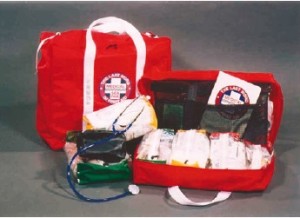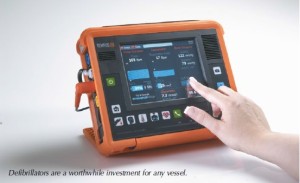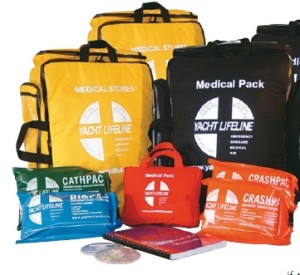
Hopefully, you’ve got a first aid kit aboard your boat. Equally hopefully, you check its contents on a regular basis. The kit may be where you left it, but the contents may not be. Painkillers, in particular, are notorious for having disappeared when needed, utilized for hangovers and UV-overdose headaches, while medical scissors have been known to end up among the office stationery or in the bathroom.
But the ability to provide first aid at sea is so vital that anyone who owns or operates a boat needs to have a serious think about it. Assuming you do have a fully equipped medical kit, would you know what to do with it in an emergency? Furthermore, will it be able to cope with an emergency 200 miles offshore? All the bandages in the world won’t help in the event of a heart attack, and, let’s face it, many who charter boats come into that middle-aged, beerdrinking, well-upholstered category who are ripe for a coronary.
Pleasure boats offer some unique medical challenges. They are associated with injuries not found anywhere else; anything from a diver with the bends to a finger impaled by a fishhook. Boating also has a unique potential for remoteness and inaccessibility. Two hundred miles may not be far for a helicopter, but bad things tend to happen in multiples. The helicopter turns up to collect a sick or injured passenger only to find the boat rocking and rolling in a Force Nine and the air thick with sleet.

It’s when someone is injured or has a sudden medical problem on your boat that you discover the enormous responsibility of being a skipper, regardless of whether your command is a 20-footer, or a 120-footer. Your crew and guests’ lives are in your hands.
How not to push the panic button
Whenever we enter any situation, our mind responds by recalling what we did the last time we were in that situation, or by slotting into the mental groove formed by relevant training. If the mind draws a blank on both counts, it does a search for any memory it has of what others have done in that situation. If it again draws a blank, it can freeze like an overloaded computer. This causes the state known as panic. All the technology in the world can come to naught if a person panics. In the wake of an accident panic often represents the single biggest danger.
In dealing with medical emergencies at sea, there are a number of steps that can be taken to help you cope without losing your cool. First, before you even take to sea, it’s important that you feel confident you are well prepared. You do this by making sure you have the right gear – a medical kit that’s suited to your boating purposes – and then that you are properly trained to use that gear.
It definitely does not help if in the midst of mayhem you are wondering where the medical kit is, what’s in it, and what you do with it. Do any of your guests know what to do if you are the one who is injured? Once an accident has occurred, the best panic preventer is to stop, think, and then act. There is a tendency for people in a crisis to rush around. Some of this rushing around may be useful, but it’s not uncommon to have several people doing a job that one person could do, while another vital job is overlooked.
Stop and take some deep breaths, collect yourself and stand back a moment. It may be hard to do if there’s blood everywhere and a lot of things happening, but the situation isn’t going to change much in that time. By taking a moment to assess it, you could well save several minutes in doing what needs to be done because you’ve got a better sense of purpose.
The next step is prioritising. You can’t do everything at once, so what comes first?
For instance, the safety of the many takes priority over the safety of one, so is the boat in danger? Or the blood covered person who is screaming and carrying on is a less urgent case than the one lying quietly on the deck, because the person screaming has an airway and is breathing, whereas we do not know if the one who is silent has an airway or is breathing.
The next step is to do the same for everyone else by delegating tasks. The best thing you can do for people who are panicking is to get them busy – even if it’s only boiling a kettle. It’s a good idea to know in advance who is good at what. If one of the crew can’t cope with the sight of blood, they can be the one responsible for sending the distress signal. A skipper who knows the capabilities of everyone on board will feel a lot more confident in a crisis.
Communication
Radio shore for help if you need it – but make sure you have the facts first. The Coastguard often has to respond to distress calls from people overreacting to relatively minor incidents, or who scream away at length about everything except the vital bits of information needed to save a life.
If someone has been seriously hurt, a quick distress call may be appropriate, especially in the middle of the night, as it takes time for emergency services to get ready to respond if a helicopter evacuation is required, and the earlier they are informed the better. You may need to write out a list first. If someone is injured or ill, three things that are useful for rescuers to know is their pulse rate, breathing rate, blood pressure, and previous medical history. They also need to know exactly what happened and when, to the minute.
Exactly what symptoms does the injured person have? Are they conscious and alert, or vague, or comatose? The rescuers need to know these things so they know what to bring.
Emergency actions
It is vital to have medical resources aboard that suit the use to which your boat is put. ‘Resources’ means not just a medical kit, but emergency equipment and appropriate training. Fishing, diving or sunbathing; day trips to Great Barrier or three weeks to Fiji; all have special dangers.
If you are planning on blue water sailing, get in touch with the Coastguard. While a CAT 1 certificate will get you port clearance, it only confirms that your boat is properly equipped. The Coastguard can make sure that you as skipper are also properly equipped. To take a boat into international waters you must have a Restricted Radio-Telephone Operator’s Certificate, for which the Coastguard runs a course. It would also be prudent to take the Sea Survival Training Course, which introduces emergency procedures including the use of life rafts, flares and the Global Maritime Distress and Safety System.
Wherever a boat is, whether in the middle of the Hauraki Gulf or the middle of the Pacific, there is going to be an interval between any incident and the arrival of aid. In that interval the skipper is liable to feel the loneliness of command. This article is definitely no substitute for a first aid course, but if it’s been a while since your last refresher, perhaps reading what follows may leave you with the useful feeling that you need to sign up for one.
The ABCs
In attending anyone who is hurt, the first priority is ABC – Airway, Breathing, and Circulation; must have an airway, must be breathing, must have a pulse and not bleeding to death.
It’s always ABC, and always in that order. The bleeding may be the obvious thing, but check their airway first. They’ll asphyxiate quicker than they’ll bleed to death.” Apart from the obvious need to stop any bleeding, shock is an important factor. Bleeding and dehydration are common causes of shock. The best immediate way to help prevent shock is to keep a person warm and raise their feet when lying down, to encourage the flow of blood back to the brain and heart.
The Bends
Radioing accurate information to shore is particularly vital if a diver suffers the bends. Rescuers need to know the depth the diver was at, the passage of time involved, and their condition upon reaching deck. If you have oxygen onboard, administer it immediately. Oxygen is the most important field treatment for any SCUBA diving injury, followed by fluids – approximately 1 litre an hour of oral fluids.
Severe Bleeding
Severe life bleeding is one of the most common causes of death. Severe bleeding can be quickly controlled by direct pressure over the injury. It is a lot of pressure for a minimum of 20 minutes. If you are able to elevate the limb, this helps in reducing the amount of bleeding.
Celox is a powder designed to stop bleeding quickly; just pour the powder in the wound. Apply direct pressure for about five minutes and the bleeding should be controlled. This is especially important for people on blood thinners such as aspirin; these medications reduce the ability of the body to clot, so if they get injured, they will bleed for two or three times longer than normal.
Concussion / Head Injury
There are two general rules of thumb. The first is; at the time of injury there is no way of telling how serious the injury is and if it is serious there is no treatment onboard. This is quite common on boats, what with swinging booms, and deck gear to trip over. The problem here is that many people have the ‘she’ll be right’ attitude. Concussion occurs when an impact causes the brain to strike the skull, which bruises it and causes it to swell. This bruising and swelling can continue for up to 24 hours, even while the victim is up and about, laughing it off. You don’t know anything is wrong until they go to sleep and you can’t wake them up again. The symptoms of concussion can be similar to those of drunkenness, including slurred speech, disorientation and addled thinking.
This can make concussion hard to detect when the victim is one of a group of mates who have got together for a few beers. The best thing is to keep them quiet and still, with low stimuli. Let rescue services know exactly how long they were unconscious. DO NOT let them go to sleep that night; keep them awake for 24 hours or until you have handed them over to higher medical assistance.
Crush Injuries
If a person is pinned under a heavy object, you have two options: either remove them within 15 minutes to an hour, or leave them pinned. While a muscle is crushed, toxins build up in the kidneys. When the pressure is released the toxins are released into the bloodstream.
If it takes over an hour to relieve the weight, the amount of toxin released means death in minutes. So if you can’t remove them straight away, it is better to leave them pinned until rescue services arrive.
Stabbing Injuries
If a person gets a foreign object in their body – say, a knife or screwdriver – it is imperative not to pull it out. It may be pressed against a blood vessel, so extracting it could cause uncontrollable bleeding. At the very least, get expert medical advice before you try anything.
Fractures
If a limb is broken, the drill is to immobilise it, splint it, and elevate it. SAM splints are the best universal splint to immobilise injuries. A danger with broken bones is that they are not always apparent. Whenever someone takes a heavy impact, excess movement should be avoided as much as possible. In dealing with impact injuries, it pays to remember that the pain is not always where the injury is.
Heart Attacks

Whether you are close to the coast and help, or somewhere between Fiji and Cairns, a heart attack or cardiac arrest can happen. Being prepared with the right equipment such as medical supplies, medication, oxygen and defibrillators can be of great assistance and often helps in saving lives. Defibrillators are a worthwhile investment for any vessel. They require no experience to use, and are proven life savers in cases of cardiac arrest.
Getting advice
There are a number of organizations that can provide both first aid training courses and medical kits. Yacht Lifeline supplies the complete range of the marine market from high-end superyachts to the casual weekend boater with unrivalled services. This includes yacht medical kits, marine first aid kits, 24/7 medical assistance, Tempus Telemedicine, STCW 95 medical training along with 24/7 yacht crisis assistance for security, fire, collision, spills and designated person ashore (DPA) alert.

The advanced marine medical kits are purposely designed to surpass MCA (MSN 1768 M+F) requirements so as to provide the best clinical outcome in the event of a medical emergency.
Yacht Lifeline was founded in New Zealand 10 years ago by former Special Forces Paramedics who have extensive knowledge and experience in remote medicine. Today the company has offices in Palma, the UK and New Zealand, with distribution outlets in the UK and NZ. The military based philosophy of ‘preparedness based on assessing and managing risk – not taking it’ – is still the strong ingrained ethos of the company. The company’s objective is to ensure the best possible clinical outcome in the event of an on-board medical emergency. All drugs and consumables are individually vacuum packed, and those requiring medical advice clearly identified. Global and Offshore Expedition MedKits include a free inventory and drug-expiry management software.
Yacht Lifeline MMS runs on your on-board PC and allows you to manage stock, find detailed medical information, log case notes and usage, view recommendations on drug application and view procedural information and digital training videos. Yacht Lifeline also provides oxygen kits and a fracture management package that includes such components as a spinal immobilisation kit, stretchers and vacuum splints. If you skipper or crew on a boat, the training and equipment supplied by the above people are not just legal requirements. They can be a matter of life or death.




